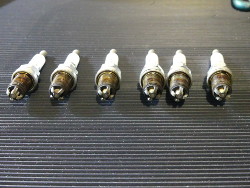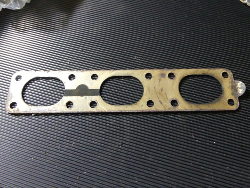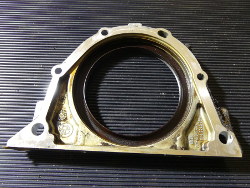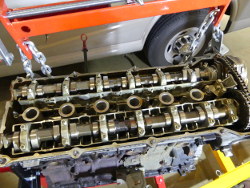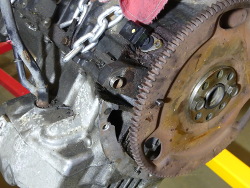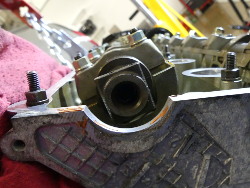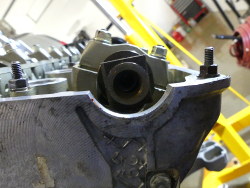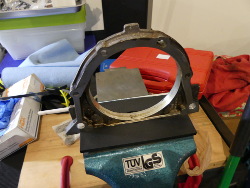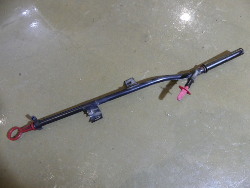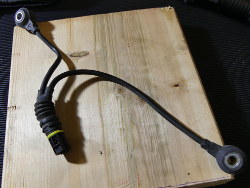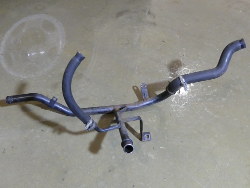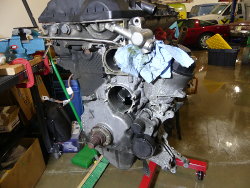Friday, July 28, 2017
Engine Disassembly Begins
I began work today by disconnecting the engine from the stand so I could reinstall the flywheel as required to lock the crankshaft with cylinder 1 at TDC with the timing pin tool. The goal here was to mark my TDC dowel so I could use it to help R&R the cams. Once the dowel was marked I again mated the engine with the stand and began to remove the valve cover.
As the cover came off I found the gasket quite brittle in areas, just as I did when I replaced the original gasket at 140K miles. By my calculation this gasket was in service for 127K miles, or 2000 miles more than my recommended replacement interval. The fact that I found lots of oil-soaked dirt at various points around the top of the head just below the valve cover suggests that my recommended 125K mile replacement interval is too high so I've changed it to 110K.
Based on largely superficial observations I can say that the head, cams, and trays appear to be in good shape. There is no varnish buildup anywhere, which is more than I can say for most engines half its age. In my opinion this validates the decision I made nearly 20 years ago to change oil at half the recommended interval. The cam lobes all appear to be in excellent shape with no obvious scoring or other mechnical wear aside from some shiny areas on the more aggressive portions of the lobes. On the "non-shiny" areas, some of texture that resulted from the abrasives used to grind the cam is still visible, which I consider amazing. Of course, I haven't removed the cams yet so I don't know how well the bearings have held up, but if they are in as good a shape as the lobes I think I will be able to safely reuse both the cams and the trays.
With the crankshaft locked such that cylinder 1 is at TDC I naturally expected the cams to be in their "well known" position (the cylinder 1 lobes pointing at each other). However, comparing the square end machined into the rear face of the cams and the face of the head where the cam locking blocks are installed, I can clearly see that the intake is at least 20 degrees off while the exhaust is a little less than half that. I don't think this is normal. If both were just a couple degrees off that might reflect slop in the timing chains but my guess is this has more to do with the vanos (perhaps the piston is hung up due to excessive radial play in the shaft) or I may be a victim of loose sprocket bolts. Maybe both. I won't know for sure until I continue the disassembly and consult with my technician.
After I pulled out the pipe that carries coolant from behind the water pump to other areas of the engine bay I noticed that it uses two o-rings (or d-rings, not sure...they're compressed quite a bit) to seal the junction. The o/d-rings are apparently available separately so should I decide to keep the pipe I'll be able to replace them but the pipe has a few areas of rust that weren't visible when installed. I don't think they're that bad but I'm planning to take a closer look at it eventually and then make the judgment call to repair or replace.
I also have to make a similar decision about the oil dipstick tube, as upon removal I noticed a good bit of rust around the area where the pipe mates with the top of the oil pan -- no doubt due to water / salt spray pooling in that location over the years. As the dipstick tube is apparently reasonably priced and there is considerable mechanical stress placed on it in the vicinity of the rust I am inclined to replace it and get on with my life. The dipstick tube uses a single o-ring to prevent water infiltration and while the original appeared to be in reasonably good shape I naturally plan to replace it.
While on the topic of engine cooling, I'll point out that I spoke with my tech the other day about the water control valves and asked for his opinion on how often they fail and whether it would make sense to do them now with the engine out of the car.
He said they are constructed with a diaphragm that ultimately cracks and causes the valve to fail, and while the failure isn't necessarily a hot-button issue with these cars it is fairly common. He also seemed surprised when I told him the valve assembly in my car is original. As for ease of replacement, he said they're not too difficult to reach with the engine installed, but one look at the empty engine bay makes it clear that replacement now would be far easier. The downside, of course, is that the valve assembly isn't cheap and the price differential to the single aftermarket vendor I found (Gates) is not enough to justify the risk of dealing with an aftermarket part.
I wrapped up the day by removing the knock sensors, vanos oil line, water pump and thermostat. Next up is removal of the oil filter housing. Once that's done I'll plan to pull the vanos, cams, and ultimately, the head, which I hope to send out early next week.
LED Lighting Update
I used one of my DIY LED lights today to illuminate my work environment for nearly four hours and I'm happy to report the light functioned reliably and the case temperature, while hot, stabilized reasonably quickly.
While this brief experience is hardly a test of long term reliability, the fact that the case is getting hot is actually a good sign in this regard, as it means heat is being transferred out of the LED panel and into the atmosphere. Based on my experience designing audio amplifiers I can say that a cool heatsink is usually a sign of a failure in either design (needless oversizing of the heatsink) or manufacturing (a high thermal resistance caused by improper coupling of the heatsink and the device).
Still, I remain pessimistic about the quality of these lights. My brother walked by and asked me why I was using only a single light. Although the real answer related to the fact that one provided sufficient illumination I couldn't help but react with "because when that one blows up I'll have a spare".
Mileage: 266865




